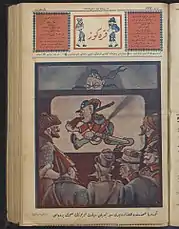Karagöz (magazine)
The Ottoman satirical magazine Karagöz (meaning “Black Eye” in English) was published from 1908 to 1955 twice a week in Istanbul.[1] Its title has its origin in one of the protagonists of the traditional Ottoman shadow play, who acted together with his friend Hacivat. Karagöz was a common person, well known for his sharp tongue and clear criticism of politics and society. Both of them appear on each front page of the magazine.
 | |
| Categories | Satire |
|---|---|
| Frequency | Twice a week |
| Founder | Ali Fuad Bey |
| Year founded | 1908 |
| Final issue | 1951 |
| Country | Ottoman Empire Turkey |
| Based in | Istanbul |
| Language | Ottoman Turkish Turkish |
| Website | Karagöz |
Among the numerous humorous magazines published since the pioneer Diyojen, Karagöz was prominent with its more than 40 years publication period. The scope of their historical and chronological documentation - from the Second Ottoman Constitutional Period, First World War, the Turkish Independence War up to the founding of the Turkish Republic - is unique.[2]
Ali Fuad Bey, the founder of the magazine, is considered to be the first Turkish cartoonist and was the publisher of numerous other magazines.[2] In the first years' editions, all the cartoons were designed by Fuad Bey himself, Mehmed Baha and Halil Naci. After Ali Fuad Bey's death in 1919, the well-known journalist Mahmud Sadık became editor-in-chief. Fuad's sister and heiress Fatima sold the magazine in 1935 to the Cumhuriyet Halk Partisi (“Republican People's Party”).[3]
The articles of the magazine were written in a popular, easy to understand and humorous language. The numerous colored and black and white cartoons also offered a clear understanding of the political, social, economic and cultural events of the time. An issue consisted of four pages, the first of which was reserved for the dialogues between Karagöz and Hacivat (Muhavere) and was devoted to daily politics and everyday problems.[1] The popular editorial "Karagözs Monologues" deals with the relationship between man and woman, with the lifestyle and the social conditions of women of Istanbul and generally with women debates.[4] Later, the publication of poems and lyrics was added.
References
- Bülent Akbaba (2014). "İnkilap tarihi öğretimi için bir kaynak: Karagöz dergisi". 22 (2): 12. Cite journal requires
|journal=(help) - "The First Turkish Cartoonist: Ali Fuad Bey". We Love ıstanbul. Retrieved 15 March 2020.
- Heinzelmann, Tobias (1999): Die Balkankrise in der Osmanischen Karikatur.Stuttgart: Steiner. p. 51.
- Türe, D. Fatma (2015): Facts and Fantasies: Images of Istanbul Women in the 1920s. Cambridge Scholars Publishing. pp. xviii-xx..